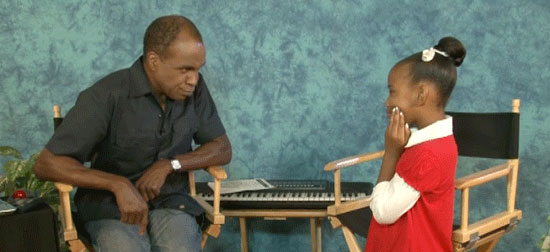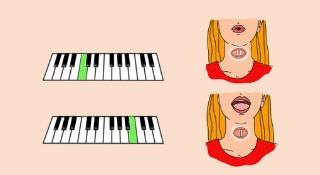How To Develop An Outstanding
Singing Vibrato
How can you develop an outstanding singing vibrato?
A vibrato that adds a touch of class to your voice everytime you switch it on... And one that you can turn on and off as you please, just like turning on a tap.
How can you do this?
Watch this video to find out!
I want to tell you about a hidden benefit of vibrato.
You see, when vibrato is flowing effortlessly in your voice it means that something good is happening. Vibrato is a sign of good vocal technique. Plus it sounds fantastic...
The chances are that once you master your singing vibrato, you will be able to connect with all areas of your voice, low and high. And your voice will most likely sound very balanced as well.
So where does vibrato voice come from, and how can you develop an effortless one? Let's explore this further...
The Secret To Star Singing
Click HERE For The Secret To Star Singing
The Secret To Star Singing
Click HERE For The Secret To Star Singing
Vibrato Definition
The Wikipedia definition of vibrato is "a musical effect consisting of a regular, pulsating change of pitch."
So what's vibrato in singing?
Vibrato in singing happens when your voice shifts quickly between two pitches. So if you were to sing a middle C, and then a C# and then a C again, followed by a C# followed by a C, you would be singing with vibrato.
The key to a great vibrato is the speed in which you change between the two pitches.
If you can oscillate between the two pitches around six times per second, you will have a very natural sounding vibrato.
What Makes Vibrato Happen?
Vibrato is the result of your sound being able to come through in a free and easy way.
Here’s what this means. When your voice is nice and relaxed, and your vocal chords are vibrating freely, they can oscillate back and forward.
This means the pitch or note you are on is changing back and forwards really quickly. This is what gives you vibrato in voice.
Other Technique Tutorials
The 3 steps to singing correctly
Understanding your vocal registers
Singing with slick vibrato
Chest voice explained
Head voice explained
The most important singing exercise ever invented
Let's Do An Exercise To Get Your Singing Vibrato Happening!

Here is a simple exercise that will allow you to see what vibrato when singing feels like.
Please understand that this is not a finished sound. It's an exaggerated version that will later be honed into something more usable.
Here's how to do the vibrato exercise.
- Place your hands at the bottom of your chest and feel where your ribs come together in the middle. Now move your hands slightly below this point. (it's the soft area a few centimeters above your belly button)
- Now sing a note on one pitch in your easy range. Any note will do.
- As you're singing this note, push in gently with your hands. The key is to push in, then pull out, and push in, then pull out and so on. Try doing this at a rate of around 3 to 4 cycles a second.
Listen to how your voice wavers in a singing vibrato like fashion.
Now it probably sounds a little exaggerated at this point, but this exercise is just give you an experience of vibrato.
Obviously you won't be doing this when you are singing a song!
So now you've had the experience of feeling vibrato in your voice, let's do another exercise that will help you develop your singing vibrato.
This Next Exercise Will Help You Develop A Beautiful Vibrato
Let’s look at another exercise that will show you how to sing in vibrato voice.
Using a simple scale we can use an “Ahhhhh” sound to practice.
If you begin each scale with no vibrato by adding a little bit of tension to your vocal chords. And then when you reach the final note in the scale, back off this tension. Allow the vibrato to come through.
Watch the demonstration below and sing along!
And here is an audio file you can use to practice with.
This Tip Will Help Kick Start Your Vibrato
There's a place in your mouth where you can apply the tiniest amount of manipulation to get your vibrato going. If you feel your sound in this place and then try to "wobble" the pitch back and forward, it will make the vibrato come through easier.
Press play on the video below to watch me demonstrate this.
An important point is that you do not need to move your jaw around (like you may have seen in some famous singers!). This will only cause you tension and make it even harder to get your vibrato going.
You only need a very subtle amount of manipulation. And if that doesn't work, it means you need to go back and use exercises to take the tightness out of your voice.
The Best Way To Use Vibrato In Your Performances?
 There are no hard and fast rules to using vibrato in your performances. Come up with your own personal style that highlights who you are as a singer.
There are no hard and fast rules to using vibrato in your performances. Come up with your own personal style that highlights who you are as a singer.There are no hard and fast rules about how to use your vibrato.
But there is a method in particular that sounds really beautiful. And it's a great place to start.
The method I’m talking about is to begin a note or phrase with no vibrato. And then just where the phrase tails off, allow a little vibrato to come through to finish the last note.
Once again, you can to this by “thinking” that you are applying a little more tension to your vocal chords in the first part of the phrase. And then letting go of this tension at the end to allow a little vibrato to come through.
Famous Vibrato Examples
Let's now take a look at some examples of famous singers using vibrato to great effect.
Watch this video and see these singers use the technique we just discussed - where they start out with a straight note and go into vibrato as the note tails off.
In this video you'll see famous female vibrato singers such as Christina Aguilera, Mariah Carey, Whitney Houston (and many more!). As well as famous male vibrato singers such as David Phelps, Lee Hyuk, Adam Lambert.
It's a valuable education to watch successful singers and take clues about how they use this vocal technique.
Once you've mastered your vibrato, you can use these performance tips to really create something compelling on stage.
What Does It Mean If You Can’t Do Vibrato?
Here’s the bottom line.
If you aren’t able to sing with vibrato it means you are too tight. In other words, there are some muscles tightening up that make it hard for your vocal chords to vibrate freely.
Luckily there are many exercises to help you create the freedom you need to easily sing with vibrato technique. You can check out these exercises here.
Once your voice has loosened up you’ll find it much easier to allow your vibrato to come through.
Sing With Freedom With These Two Tips
Because singing with freedom will help your natural singing vibrato come through, let's check out some tips to free your voice.
- Focus on keeping your sound above your cheeks. Using this vocal placement will keep your swallowing muscles from tightening too much. This is a BIG key to singing with freedom.
- Place your thumb under your jaw when you are practicing. This will give you awareness for when your swallowing muscles are tightening. Which in turn allows you to keep them relaxed.
Using these little "tricks" when you practice will keep your voice nice and free...
... Allowing that beautiful vibrato to happen nice and naturally!
Now let's talk about a different problem.
What If You Have Too Much Vibrato?
You might have the opposite program where too much is coming through.
Perhaps your voice always seems to have a vibrato in it. Or maybe your vibrato is really noticeable and obtrusive, when you’d prefer it to be more subtle.
How To Turn Off The Vibrato
Let's talk about the problem of not being able to turn your vibrato off.
You want to be able to have full control over your vibrato. This means you can turn it on and off whenever you like. And you can add different amounts of it, so each note you sing has maximum impact.
Watch this video to see me demonstrate how to turn your vibrato off (It will begin at the correct place)
Here’s how you do it.
To sing without vibrato you add a little more tension onto your vocal chords.
Doing this helps your voice to produce a note that stays true and solid.
Another way of thinking about it is your vocal chords are holding together a little tighter.
Then you can relax the voice, which allows the vibrato to come through.
Because relaxing the voice will mean the vocal chords won't hold together quite so tightly. This allows the pitch to begin to oscillate or pulsate, creating the vibrato effect.
Turning Your Vibrato On
As I just mentioned, by backing off of this slight bit of tension you’ve put on your vocal chord - the voice relaxes and the vibrato begins to come through.
Singers often ask me:
Do You Have To FORCE Your Vibrato To Come Through?
My answer is that the word “force” is not quite right.
There is a little bit of manipulation you can do to get the vibrato started. Then it continues on effortlessly.
One thing you can do if you are struggling to get your vibrato going is practice singing two notes that are side by side. Go back and forward between these two notes nice and easily. And then try to speed it up so it begins sounding like a vibrato.
Still Can’t Get Your Vibrato Going?
If you practice the above exercise and aren’t making progress, don’t worry!
First, developing techniques like vibrato take time and practice. As long as you stick with it, you will get there in the end.
Second, it just means there’s a little too much tension on your voice.
This might mean you’ve picked up some bad habits over the years that causing you to tighten up.
This isn’t a big deal and can be easily fixed. Check out this tutorial on how to sing and go through some exercises that will create more freedom in your voice.
Frequently Asked Questions About Vibrato
I get asked a lot of questions about vibrato. Here are some of the most common ones along with their answers:
Is Vibrato Good For Singers?
Generally speaking vibrato is good for singers. It’s a sign that your voice is creating sound in a nice and relaxed way. See, the vocal chords need the muscles around them to be relaxed to oscillate freely.
The opposite is also true that if you cannot sing with vibrato it means your voice is too tight. If this is the case, do not worry! A few simple exercises can free up your voice and allow your vibrato to start coming through.
Is Vibrato Difficult?
Vibrato is not difficult when you understand how to create it. When you are able to relax your vocal chords slightly it will allow them to oscillate freely between two pitches.
Things only get difficult if you have picked up a few bad habits that are preventing you from creating your sound in a free way. If so, it just means you need to use exercises that will take strain off of your voice. Once you’ve done this, you will find vibrato will come through nice and easily.
Is Vibrato Natural or Learned?
The answer is both!
Vibrato is something that happens very naturally when your vocal technique is solid. Particularly when your voice is creating sound with a lot of freedom.
But it is also a skill that can be learned. There are vibrato exercises on this page that will help you develop it. Essentially you will want to do two things.
1. Use voice exercises that allow your voice to produce sound with a lot of freedom.
2. Use these exercises to begin creating singing vibrato.
Is Vibrato Bad For The Voice?
Vibrato is mostly good for the voice. The only time it is bad is if you have too much vibrato that you can’t control. If your voice is always in vibrato mode, it can be a little overbearing. And also, long term it is possible to cause damage to the voice.
If you are having this problem, it means you are too open in the back of your throat. So you need to put a little more tension on your vocal chords to hold them together. This keeps the pitch of your note steady and holds the vibrato at bay.
How Do You Get Vibrato In Your Voice?
You get vibrato in your voice by slightly backing off the tension applied to your vocal chords. This causes them to relax slightly and begin to oscillate between two pitches quickly - creating the vibrato voice effect.
Conclusion
I hope that helps you understand how to create vibrato in your singing!
As you've learned in this tutorial, there are 2 very effective exercises for introducing vibrato into your singing.
And when you get it going it sounds beautiful!
I have a free email course that includes many highly effective exercises that will help you develop an amazing vibrato. You will also learn how to increase your vocal range, improve your tone quality, and gain greater control over your voice.
Check out the link below to get this course.
Click here to develop a silky smooth singing vibrato!
Recommended Videos
Related Singing Lessons

Singing Tips For An Effortless Vibrato
About The Author
 Roger Burnley - Vocal Coach Roger Burnley - Vocal Coach |
Roger Burnley is a vocal coach located in Hollywood, California. He has been teaching singers for over 30 years and singing for even longer than that.
Notable past and present clients include Macy Gray, Brandy, Ray J, The Beastie Boys, James Torme, Taylor Lautner, Nona Gaye, and many more.
His clients have collectively sold more than 30 million albums, with several reaching Platinum and Gold status.
Roger has been featured on VH1, TV Guide Channel, TV One,
and MTV appearing as a vocal expert.
About The Author
 Roger Burnley - Vocal Coach Roger Burnley - Vocal Coach |
Roger Burnley is a vocal coach located in Hollywood, California. He has been teaching singers for over 30 years and singing for even longer than that.
Notable past and present clients include Macy Gray, Brandy, Ray J, The Beastie Boys, James Torme, Taylor Lautner, Nona Gaye, and many more.
His clients have collectively sold more than 30 million albums, with several reaching Platinum and Gold status.
Roger has been featured on VH1, TV Guide Channel, TV One,
and MTV appearing as a vocal expert.











New! Comments
Show me you're alive! Leave a comment below...